Field Measurements of Longshore Sediment Transport along Denu Beach, Volta Region, Ghana
Abstract
1. Introduction
2. Materials and Methods
2.1. Study Area
2.2. Data Collection
2.2.1. Wave Parameters
2.2.2. Longshore Velocity Measurement
2.2.3. Computation of Longshore Velocity
2.2.4. The Sediment Transport Measurement
2.2.5. Standardization of the Cross-Shore Positions of the Traps
2.2.6. Prediction of Longshore Sediment Transport Rates
3. Results
3.1. Wave Parameters and Longshore Current
3.2. Longshore Sediment Transport Rates
3.3. Beach and Surf Zone Median Grain Size
3.4. Vertical and Cross-Shore Distribution of LST and the Grain-Size
3.5. Influence of the Hydrodynamic Factors on the Longshore Sediment Transport
4. Discussion
4.1. Sand Transport Rates
4.2. Distribution of the Sand Transport Rates and the Grain Size
4.3. Sand Transport and Hydrodynamic Factors
5. Conclusions
Author Contributions
Funding
Informed Consent Statement
Data Availability Statement
Acknowledgments
Conflicts of Interest
References
- Sundar, V.; Sannasiraj, S. Longshore sediment transport rate from the field measured wave and sediment characteristics along the coast of Karaikal, India. ISH J. Hydraul. Eng. 2022, 1–12. [Google Scholar] [CrossRef]
- O’grady, J.; Babanin, A.; McInnes, K. Downscaling Future Longshore Sediment Transport in South Eastern Australia. J. Mar. Sci. Eng. 2019, 7, 289. [Google Scholar] [CrossRef]
- Ostrowski, R. On Uncertainties in Determination of Sediment Transport Rates in Coastal Regions. Arch. Hydro-Eng. Environ. Mech. 2016, 63, 265–280. [Google Scholar] [CrossRef]
- Giardino, A.; Schrijvershof, R.; Nederhoff, C.; de Vroeg, H.; Brière, C.; Tonnon, P.-K.; Caires, S.; Walstra, D.; Sosa, J.; van Verseveld, W.; et al. A quantitative assessment of human interventions and climate change on the West African sediment budget. Ocean Coast. Manag. 2018, 156, 249–265. [Google Scholar] [CrossRef]
- Xorse, T.M. Impact of Wave Dynamics on the Coast of Ghana. Ph.D. Thesis, University of Ghana, Accra, Ghana, 2013. [Google Scholar]
- Almar, R.; Kestenare, E.; Reyns, J.; Jouanno, J.; Anthony, E.; Laibi, R.; Hemer, M.; Du Penhoat, Y.; Ranasinghe, R. Response of the Bight of Benin (Gulf of Guinea, West Africa) coastline to anthropogenic and natural forcing, Part1: Wave climate variability and impacts on the longshore sediment transport. Cont. Shelf Res. 2015, 110, 48–59. [Google Scholar] [CrossRef]
- Addo, K.A. Assessing Ocean Wave Dynamics, Potential Sediment Transport, and Coastal Erosion along Accra Coast in Ghana. J. Coast. Res. 2018, 81, 86. [Google Scholar] [CrossRef]
- Angnuureng, D.B.; Jayson-Quashigah, P.-N.; Addo, K.A.; Aheto, D.W.; Almar, R.; Bonou, F.; Brempong, E. Quantification of the Shoreline Evolution of an Open Beach between Coastal Defenses. In Proceedings of the 9th International Conference: Coastal Sediments 2019, Petersburg, FL, USA, 27–31 May 2019; pp. 1562–1576. [Google Scholar] [CrossRef]
- Shaeri, S.; Etemad-Shahidi, A.; Tomlinson, R. Revisiting Longshore Sediment Transport Formulas. J. Waterw. Port Coast. Ocean Eng. 2020, 146, 04020009. [Google Scholar] [CrossRef]
- Sadeghifar, T.; Barati, R. Application of Adaptive Neuro-Fuzzy Inference System to Estimate Alongshore Sediment Transport Rate (A Real Case Study: Southern Shorelines of Caspian Sea). J. Soft Comput. Civ. Eng. 2018, 2, 72–85. [Google Scholar] [CrossRef]
- Gholami, Z.; Lari, K.; Bidokhti, A.A.; Javid, A. Revisiting the derivation of bulk longshore sediment transport rates using meta-heuristic algorithms. Ocean Coast. Res. 2021, 69, 1–11. [Google Scholar] [CrossRef]
- US Army. Shore Protection Manual; Corps of Engineers, Beach Erosion Board: Fort Belvoir, VA, USA, 1984; pp. 1–230. [Google Scholar]
- Kamphuis, J.W. Alongshore sediment transport rate. J. Waterw. Port Coast. Ocean. Eng. 1991, 117, 624–640. [Google Scholar] [CrossRef]
- van Rijn, L.C. A simple general expression for longshore transport of sand, gravel and shingle. Coast. Eng. 2014, 90, 23–39. [Google Scholar] [CrossRef]
- Adjei, P.O.W.; Cazcarro, I.; Arto, I.; Ofori-Danson, P.K.; Asenso, J.K.; Codjoe, S.N. Biophysical and socioeconomic state of the Volta Delta region of Ghana from the perspectives of gender and spatial relations. In Deltas, Vulnerability and Climate Change: Migration and Adaptation; Working Paper; DECCMA: Southampton, UK, 2018; pp. 1–26. [Google Scholar]
- Jayson-Quashigah, P.-N.; Addo, K.A.; Amisigo, B.; Wiafe, G. Assessment of short-term beach sediment change in the Volta Delta coast in Ghana using data from Unmanned Aerial Vehicles (Drone). Ocean Coast. Manag. 2019, 182, 104952. [Google Scholar] [CrossRef]
- Nicholls, R.J.; Adger, W.N.; Hutton, C.W.; Hanson, S.E. Delta Challenges and Trade-Offs from the Holocene to the Anthropocene BT-Deltas in the Anthropocene; Nicholls, R.J., Adger, W.N., Hutton, C.W., Hanson, S.E., Eds.; Springer International Publishing: Cham, Germany, 2020; pp. 1–22. [Google Scholar]
- Gampson, E.K.; Nartey, V.K.; Golow, A.A.; Akiti, T.T.; Sarfo, M.A.; Salifu, M.; Fuseini, A.R. Physical and isotopic characteristics in peri-urban landscapes: A case study at the lower Volta River Basin, Ghana. Appl. Water Sci. 2017, 7, 729–744. [Google Scholar] [CrossRef]
- Sørensen, T.H.; Vølund, G.; Armah, A.K.; Christiansen, C.; Jensen, L.B.; Pedersen, J.T. Temporal and spatial varations in concentrations of sediment nutrients and carbon in the Keta lagoon, Ghana. West Afr. J. Appl. Ecol. 2003, 4. [Google Scholar]
- Appeaning Addo, K.; Jayson-Quashigah, P.N.; Codjoe SN, A.; Martey, F. Drone as a tool for coastal flood monitoring in the Volta Delta, Ghana. Geoenviron. Disasters 2018, 5, 13. [Google Scholar] [CrossRef]
- Roest, L.W.M. The Coastal System of the Volta Delta, Ghana: Strategies and Opportunities for Development; TU Delft Delta Infrastures and Mobility Initiative (DIMI): Delft, The Netherlands, 2018. [Google Scholar]
- Horikawa, K. Nearshore Dynamics and Coastal Processes: Theory, Measurement, and Predictive Models; University of Tokyo Press: Tokyo, Japan, 1988. [Google Scholar]
- Hamid, N. Study of Community Capacity in Dealing with The Threat of Shore Erosion in Kragan Subdistrict Rembang District. Pancar. Pendidik. 2018, 7, 57–70. [Google Scholar] [CrossRef]
- Quadrado, G.P.; Goulart, E.S. Longshore sediment transport: Predicting rates in dissipative sandy beaches at southern Brazil. SN Appl. Sci. 2020, 2, 1–13. [Google Scholar] [CrossRef]
- Bradford, S.F.; Sanders, B.F. Finite-Volume Model for Shallow-Water Flooding of Arbitrary Topography. J. Hydraul. Eng. 2002, 128, 289–298. [Google Scholar] [CrossRef]
- Longuet-Higgins, M.S. Longshore currents generated by obliquely incident sea waves: 1. J. Geophys. Res. 1970, 75, 6778–6789. [Google Scholar] [CrossRef]
- Komar, P.D. Nearshore Currents: Generation by Obliquely Incident Waves and Longshore Variations in Breaker Height. In Nearshore Sediment Dynamics and Sedimentation; John and Wiley and Sons: Hoboken, NJ, USA, 1975. [Google Scholar]
- van Rijn, L.C. Longshore Sand Transport. In Proceedings of the 28th ICCE, Cardiff, UK, 1–13 July 2003. [Google Scholar]
- Kraus, N.C. Application of portable traps for obtaining point measurements of sediment transport rates in the surf zone. J. Coast. Res. 1987, 3, 139–152. [Google Scholar]
- Kraus, N.C.; Gingerich, K.J.; Rosati, J.D. DUCK85 SURF ZONE SAND; US Army Corps of Engineers: Bronx, NY, USA, 1989. [Google Scholar]
- Wang, P.; Kraus, N.C.; Davis, R., Jr. Total longshore sediment transport rate in the surf zone. J. Coast. Res. 1998, 14, 269–282. [Google Scholar]
- Levoy, F.; Monfort, O.; Rousset, H.; Larsonneur, C. Quantification of Longshore Transport in the Surf Zone on Macrotidal Beaches. In Coastal Engineering; Taylor and Francis: Abingdon, UK, 1994. [Google Scholar]
- CEM. U.S. Army Engineer Research and Development Center, Coastal and Hydraulics Laboratory. In Coastal Engineering Manual; CEM: Vicksburg, MS, USA, 2003. [Google Scholar]
- Smith, E.R.; Wang, P.; Ebersole, B.A.; Zhang, J. Dependence of Total Longshore Sediment Transport Rates on Incident Wave Parameters and Breaker Type. J. Coast. Res. 2009, 253, 675–683. [Google Scholar] [CrossRef]
- Soltau, C. The Cross-Shore Distribution of Grain Size in the Longshore Transport Zone. Ph.D. Thesis, University of Stellenbosch, Stellenbosch, South Africa, 2009. [Google Scholar]
- Einstein, H.A. The Bed-Load Function for Sediment Transportation in Open Channel Flows (No. 1026); US Department of Agriculture: Washington, DC, USA, 1950. [Google Scholar]
- van Rijn, L.C. Unified view of sediment transport by currents and waves. I: Initiation of motion, bed roughness, and bed-load transport. J. Hydraul. Eng. 2007, 133, 649–667. [Google Scholar] [CrossRef]
- Cartier, A. Évaluation des Flux Sédimentaires sur le Littoral du Nord-Pas de Calais: Vers Une Meilleure Compréhension de la Morphodynamique des Plages Macrotidales. Ph.D. Thesis, Université du Littoral Côte d’Opale, Calais, France, 2011. [Google Scholar]
- Briggs, T.R.; Figlus, J.; Torres-Freyermuth, A.; Puleo, J.A.; Warren, W.; Alrushaid, T. Variability in Onshore Sediment Transport on a Natural Beach during a Central American Cold Surge Event. J. Coast. Res. 2020, 36, 487–497. [Google Scholar] [CrossRef]
- Kumbhakar, M.; Kundu, S.; Ghoshal, K. An explicit analytical expression for bed-load layer thickness based on maximum entropy principle. Phys. Lett. A 2018, 382, 2297–2304. [Google Scholar] [CrossRef]
- Guta, H.; Hurther, D.; Chauchat, J. Bedload and Concentration Effects on Turbulent Suspension Properties in Heavy Particle Sheet Flows. J. Hydraul. Eng. 2022, 148, 04022012. [Google Scholar] [CrossRef]
- Zhu, Z.; Yu, J. Estimating the Bed-Load Layer Thickness in Open Channels by Tsallis Entropy. Entropy 2019, 21, 123. [Google Scholar] [CrossRef] [PubMed]
- Storlazzi, C.D.; Norris, B.; Rosenberger, K.J. The influence of grain size, grain color, and suspended-sediment concentration on light attenuation: Why fine-grained terrestrial sediment is bad for coral reef ecosystems. Coral Reefs 2015, 34, 967–975. [Google Scholar] [CrossRef]
- Rogers, A.L.; Ravens, T.M. Measurement of longshore sediment transport rates in the surf zone on Galveston Island, Texas. J. Coast. Res. 2008, 24, 62–73. [Google Scholar] [CrossRef]
- Lasgaa, H. Evaluation du Transport Sédimentaire Longshore–Cross Shore du Littoral de Saidia–Cap de l’Eau (Maroc Nord-Est). Rev. Maroc. De Géomorpholo 2018, 1–17. [Google Scholar]
- Wang, P.; Smith, E.R.; Ebersole, B.A. Large-scale laboratory measurements of longshore sediment transport under spilling and plunging breakers. J. Coast. Res. 2002, 18, 118–135. [Google Scholar]
- Yu, X.; Li, S.; Li, S. Sandy Coast (Shore) and Neritic Depositional System. In Clastic Hydrocarbon Reservoir Sedimentology; Springer: Cham, Switzerland, 2018; pp. 573–632. [Google Scholar] [CrossRef]

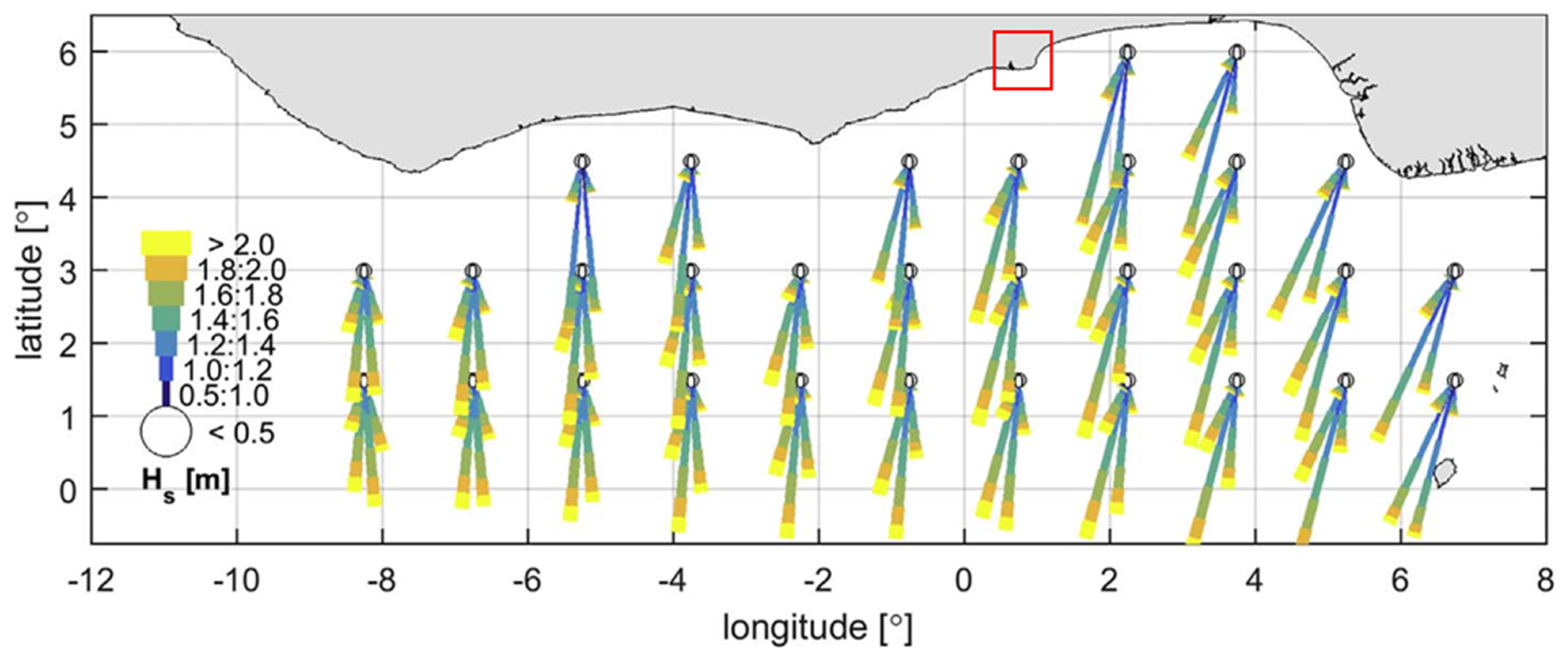
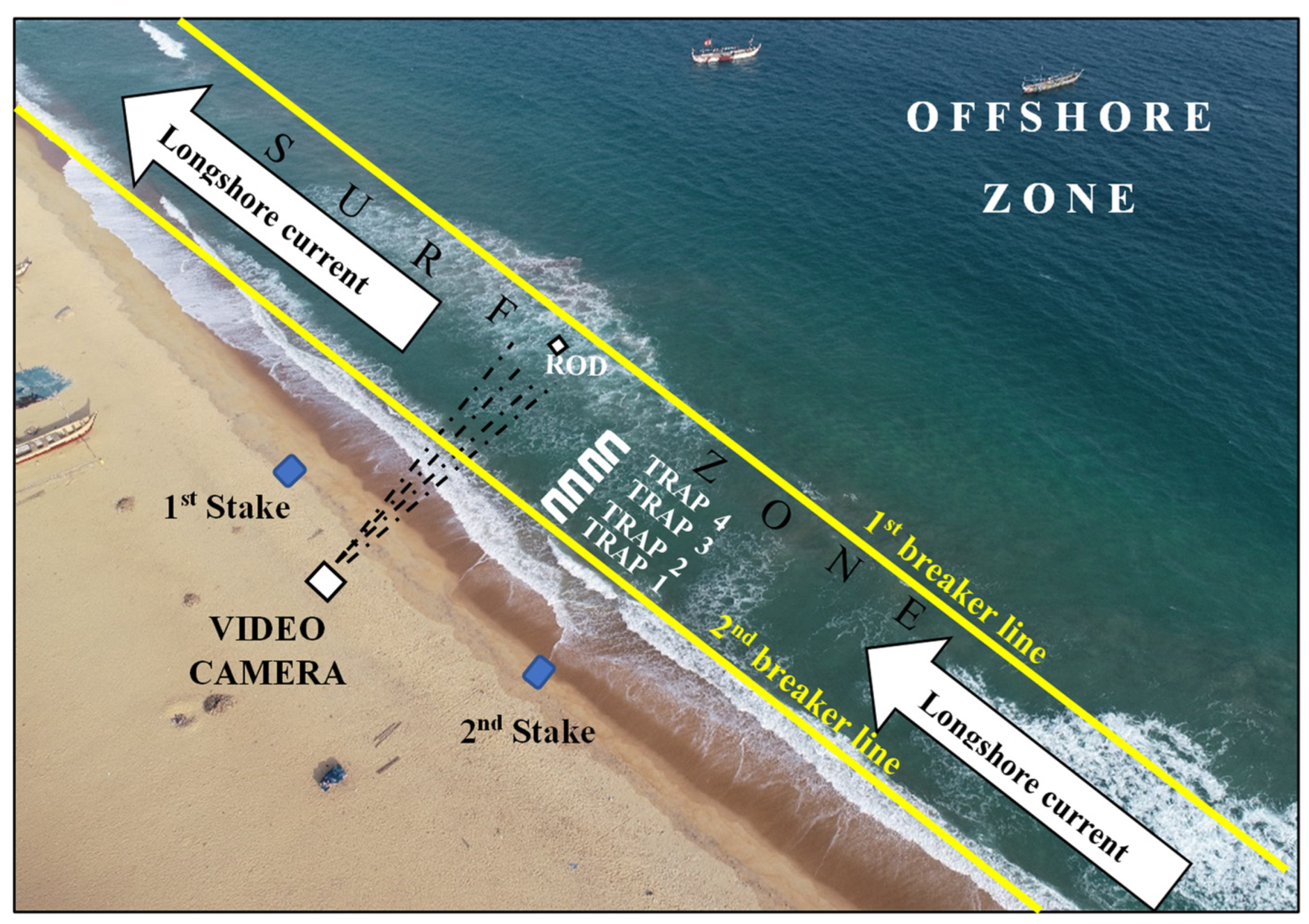

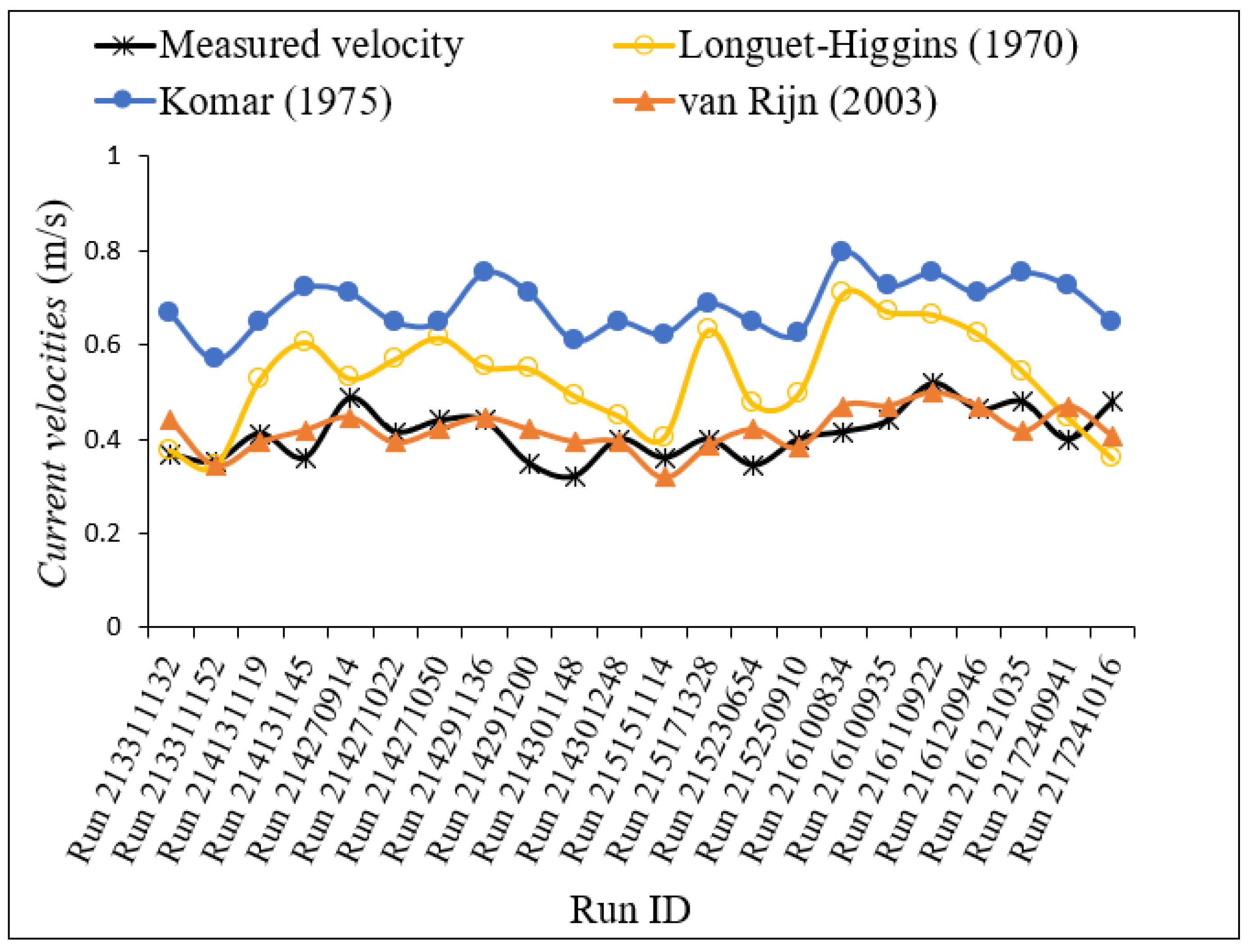
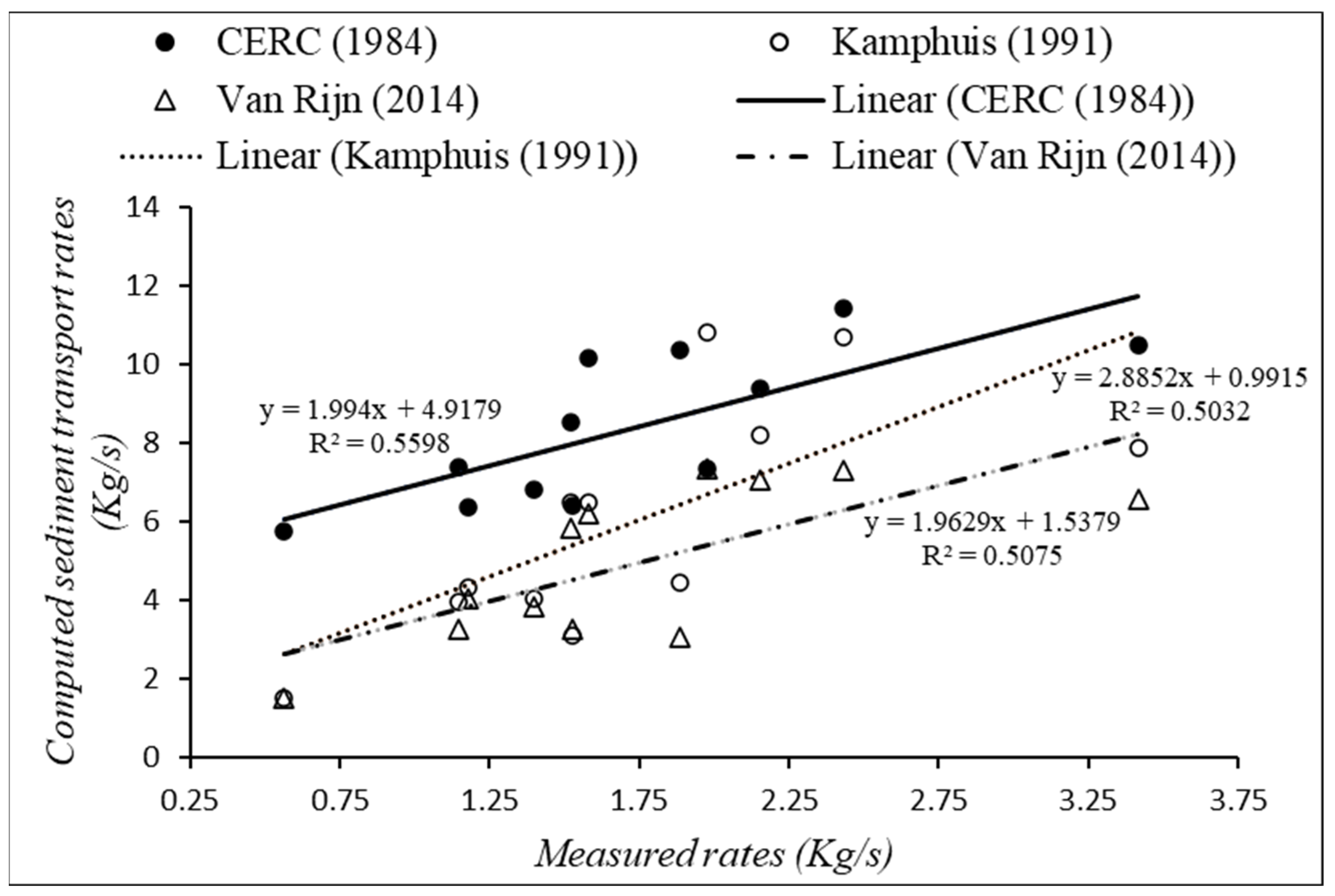
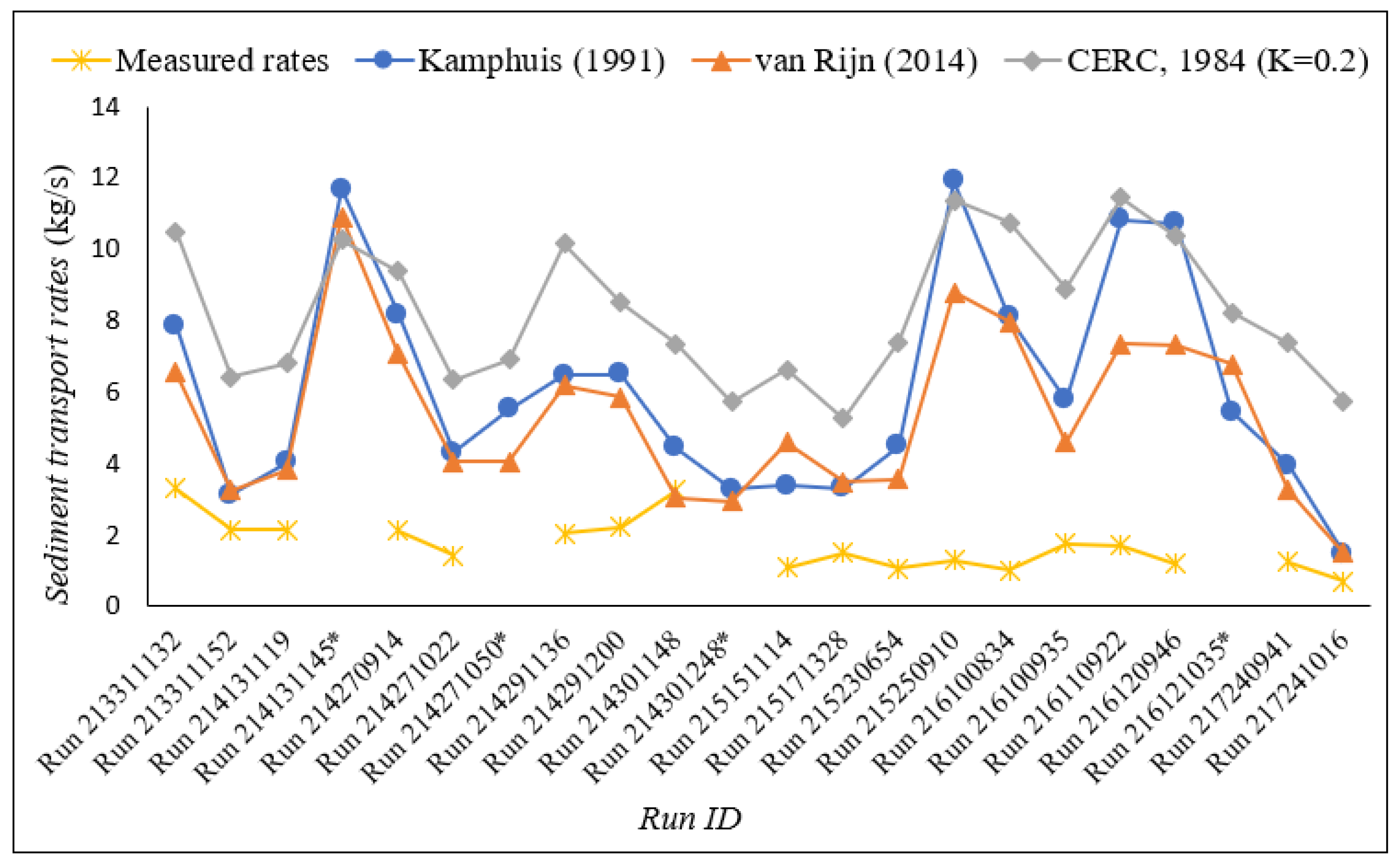
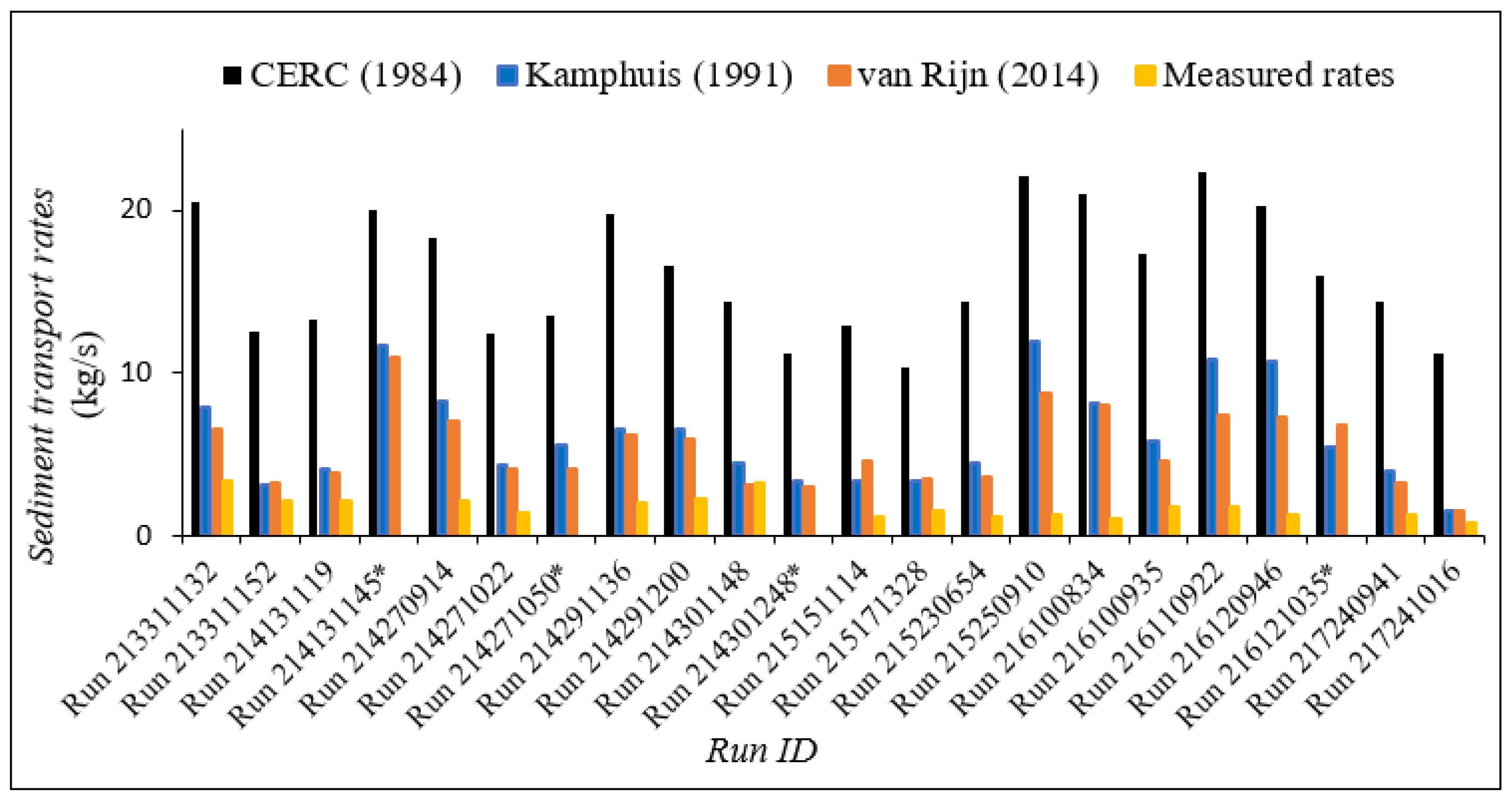

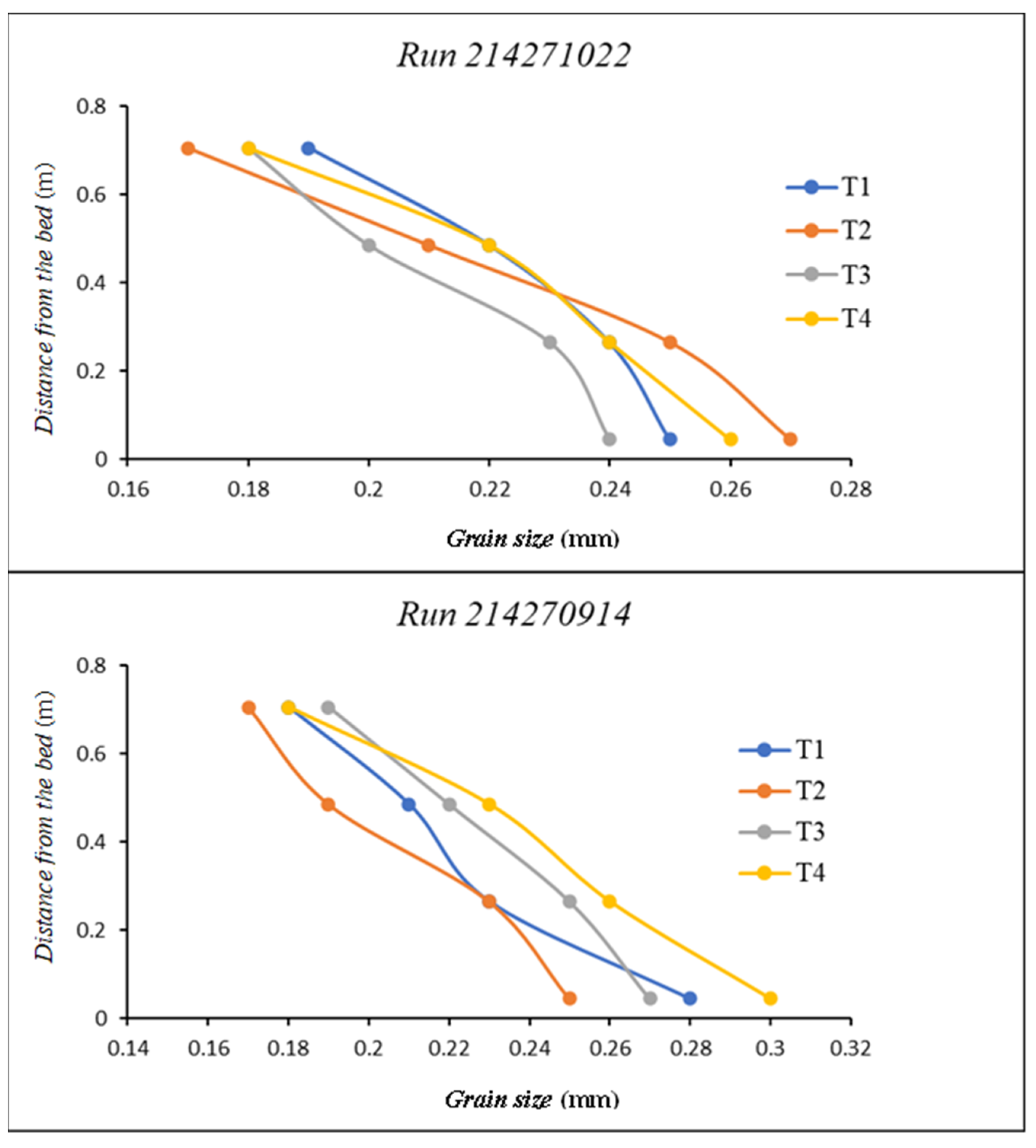
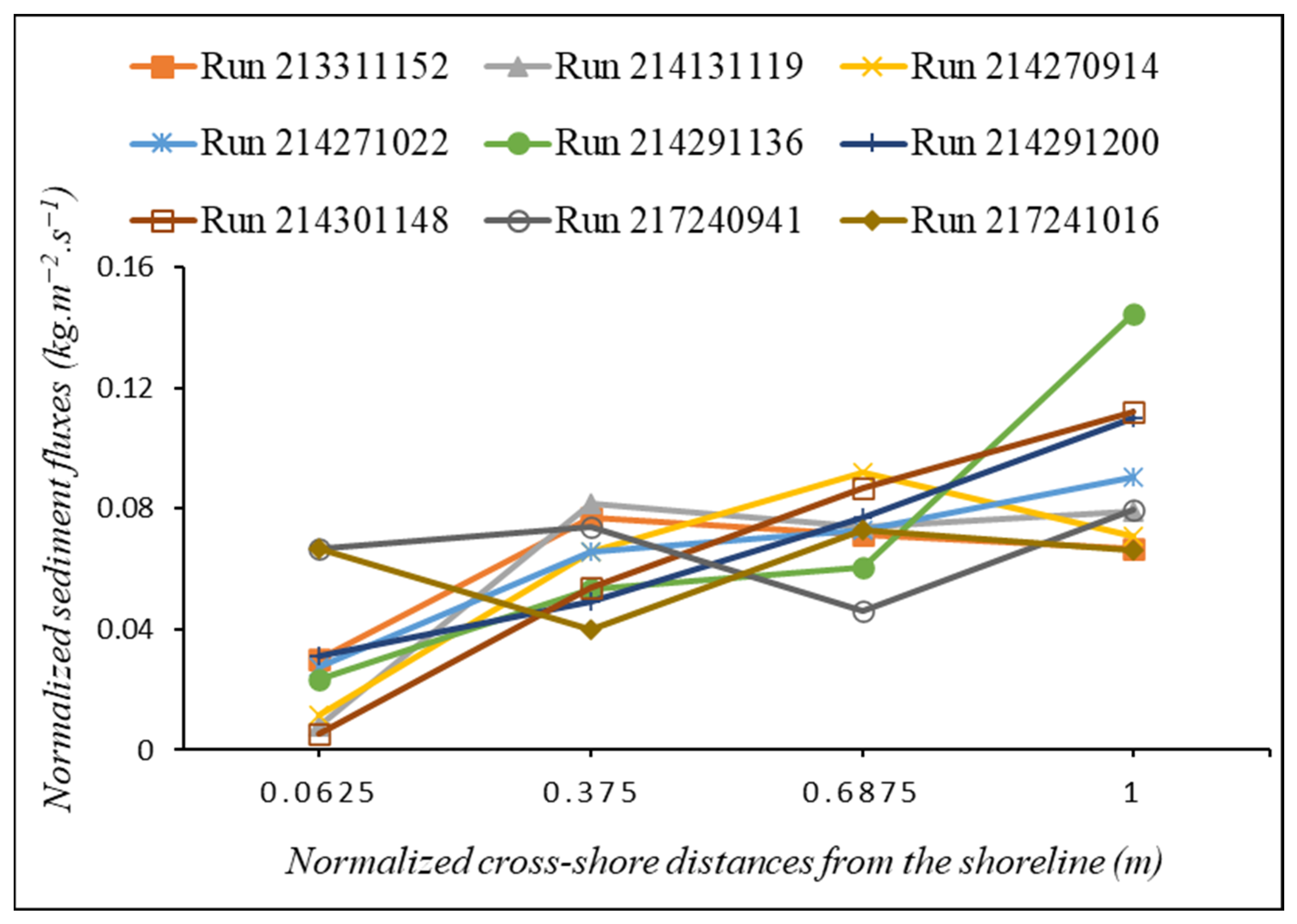
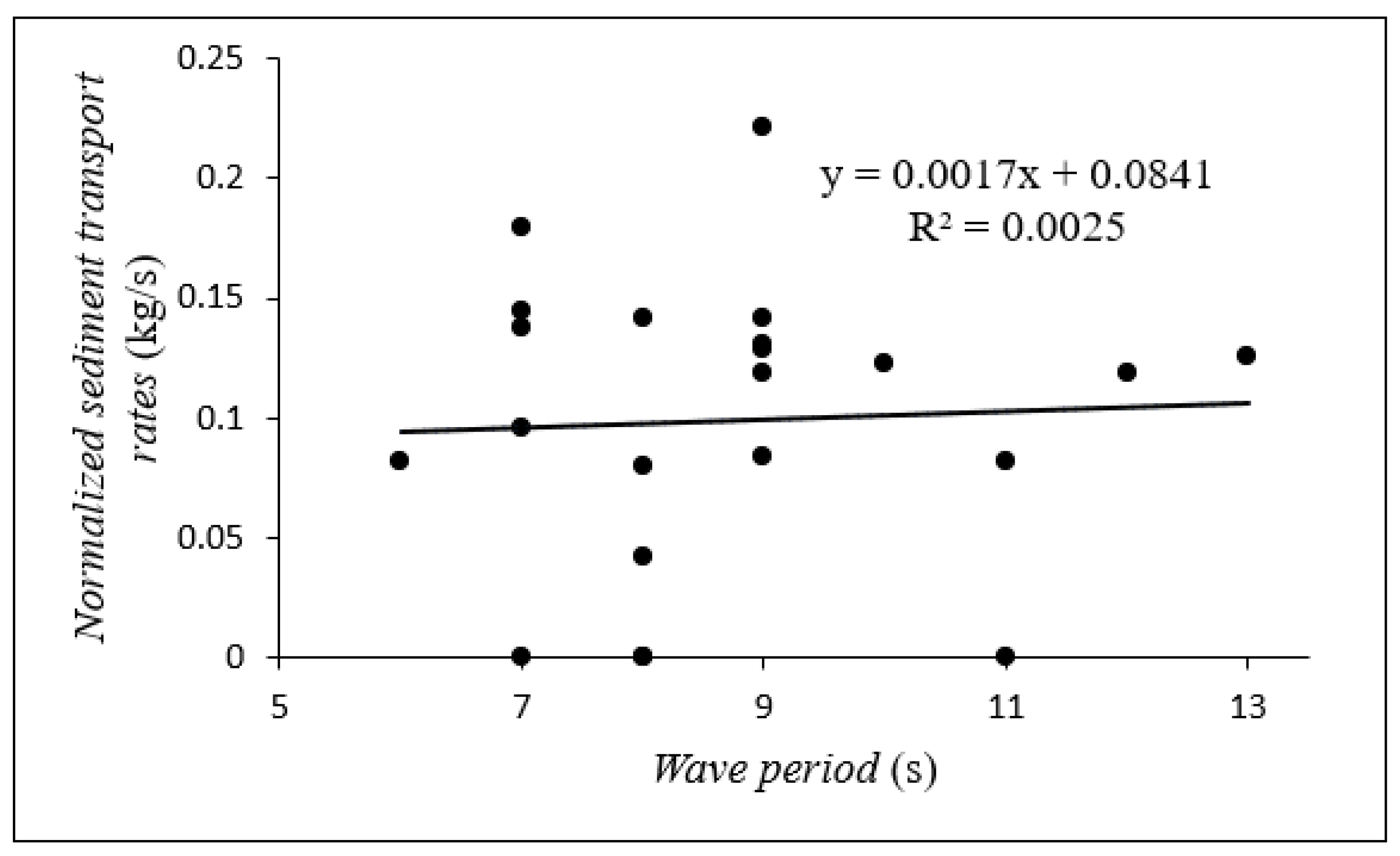
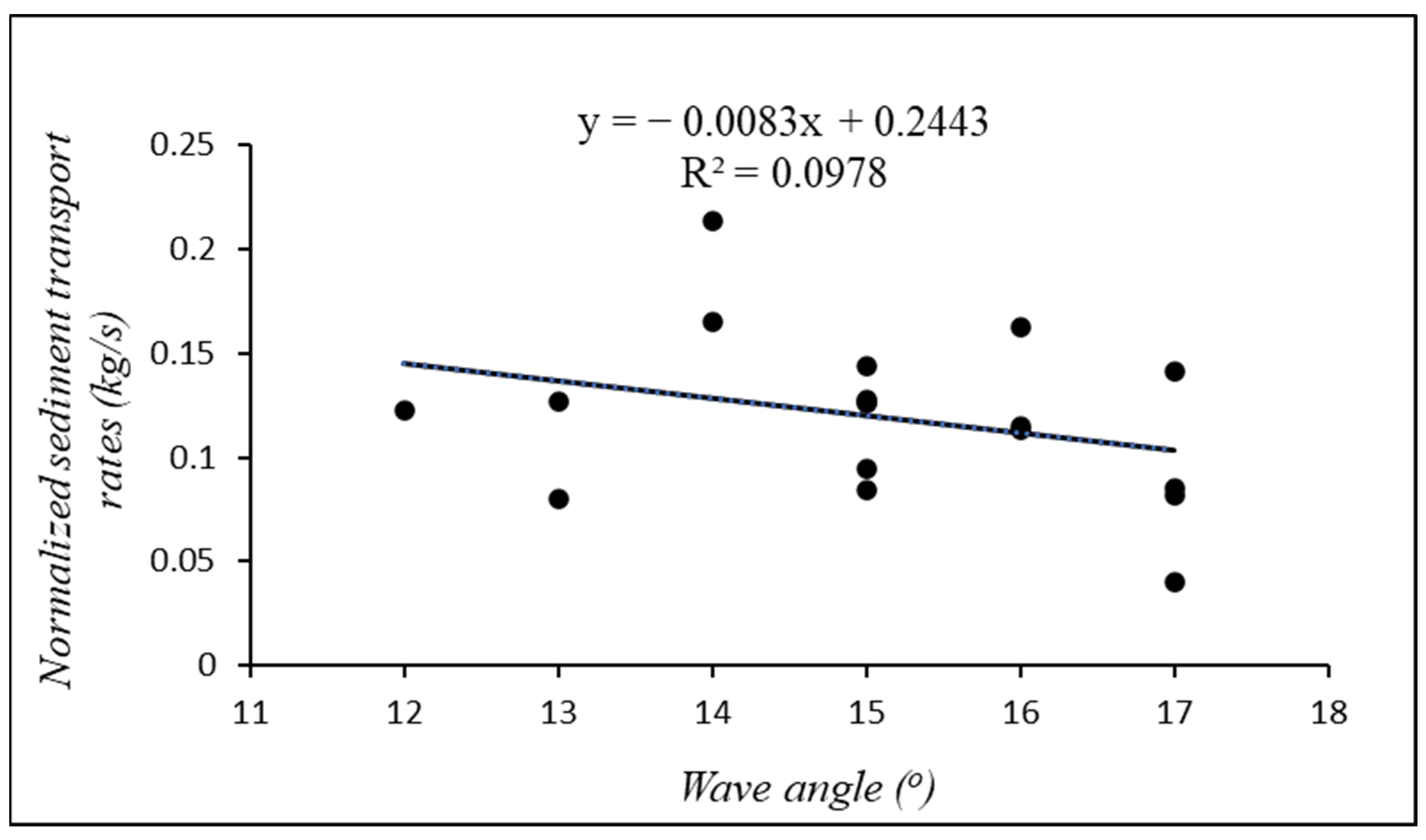



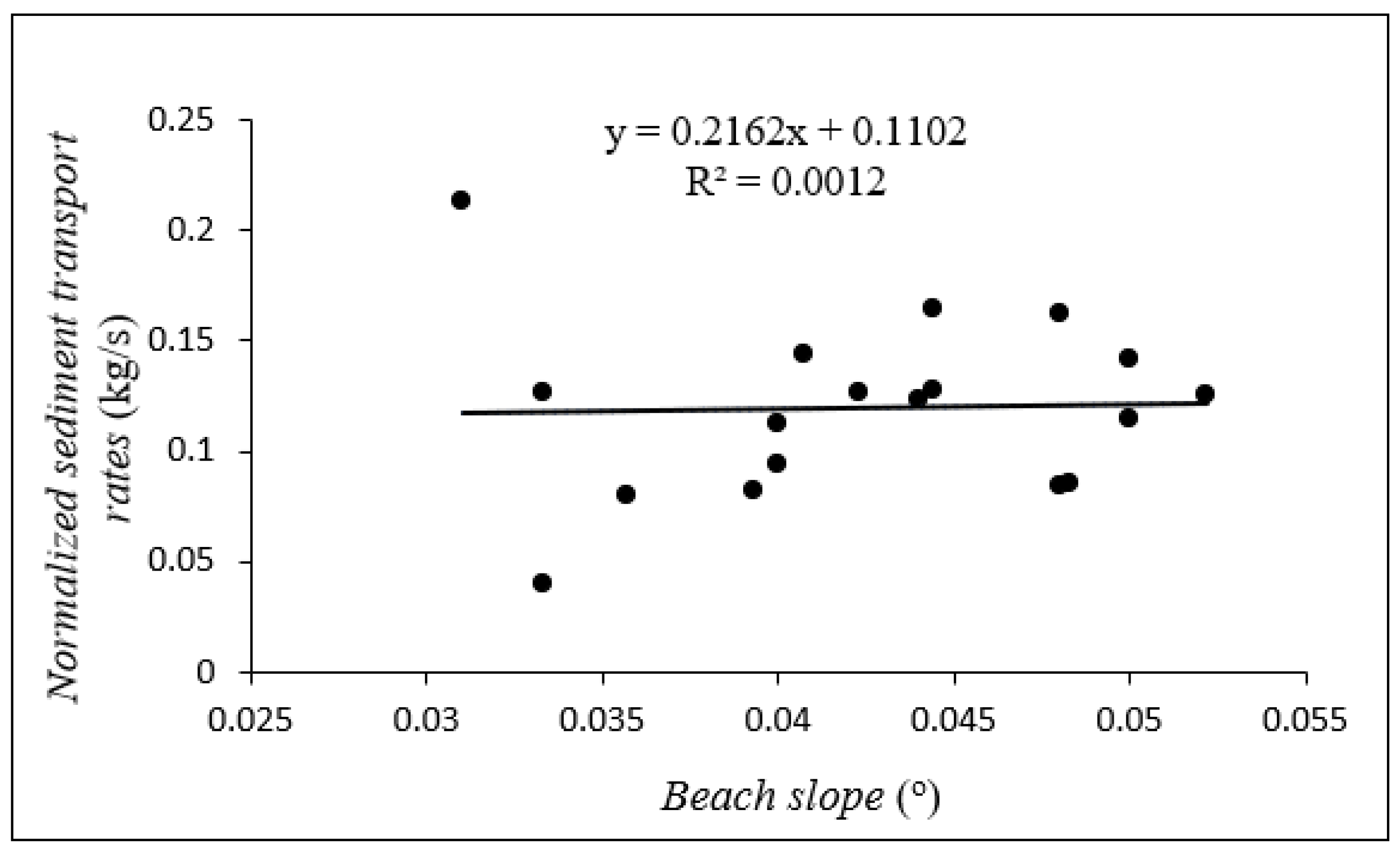
| Date | Run ID | Significant Wave Height (m) | Wave Period (s) | Breaker Angle (°) | Mean Longshore Velocity (m·s−1) |
|---|---|---|---|---|---|
| 31/03/2021 | 213311132 | 1.0 | 9 | 14 | 0.37 |
| 213311152 | 0.7 | 9 | 13 | 0.35 | |
| 13/04/2021 | 214131119 | 0.7 | 7 | 15 | 0.41 |
| 214131145 | 0.9 | 7 | 14 | 0.36 | |
| 27/04/2021 | 214270914 | 0.9 | 8 | 15 | 0.49 |
| 214271022 | 0.7 | 8 | 15 | 0.42 | |
| 214271050 | 0.8 | 8 | 15 | 0.44 | |
| 29/04/2021 | 214291136 | 0.8 | 10 | 16 | 0.44 |
| 214291200 | 0.8 | 9 | 15 | 0.35 | |
| 30/04/2021 | 214301148 | 0.8 | 7 | 14 | 0.32 |
| 214301248 | 0.7 | 8 | 15 | 0.40 | |
| 15/05/2021 | 215151114 | 0.6 | 9 | 13 | 0.36 |
| 17/05/2021 | 215171328 | 0.8 | 9 | 16 | 0.40 |
| 23/05/2021 | 215230654 | 0.6 | 7 | 15 | 0.34 |
| 215230742 | 0.6 | 7 | 16 | 0.40 | |
| 25/05/2021 | 215250910 | 0.8 | 13 | 12 | 0.42 |
| 10/06/2021 | 216100834 | 1.1 | 6 | 17 | 0.44 |
| 216100935 | 1 | 9 | 17 | 0.52 | |
| 11/06/2021 | 216110922 | 0.8 | 7 | 16 | 0.46 |
| 216110956 | 0.8 | 9 | 17 | 0.48 | |
| 12/06/2021 | 216120946 | 1 | 12 | 15 | 0.4 |
| 216121035 | 0.7 | 11 | 16 | 0.48 | |
| 24/07/2021 | 217240941 | 1.0 | 11 | 17 | 0.37 |
| 217241016 | 1.1 | 8 | 17 | 0.35 |
| Run ID | Surf Zone d50 | Beach d50 |
|---|---|---|
| Run 213311132 | 0.17 | 0.32 |
| Run 213311152 | 0.2 | 0.33 |
| Run 214131119 | 0.23 | 0.43 |
| Run 214131145 | 0.21 | 0.45 |
| Run 214270914 | 0.2 | 0.46 |
| Run 214271022 | 0.22 | 0.47 |
| Run 214271050 | 0.23 | 0.47 |
| Run 214291136 | 0.27 | 0.48 |
| Run 214291200 | 0.28 | 0.47 |
| Run 214301148 | 0.3 | 0.5 |
| Run 214301248 | 0.32 | 0.48 |
| Run 215151114 * | 0.3 | 0.32 |
| Run 215171328 * | 0.32 | 0.59 |
| Run 215230654 * | 0.24 | 0.47 |
| Run 215250910 * | 0.23 | 0.5 |
| Run 216100834 | 0.22 | 0.57 |
| Run 216100935 * | 0.22 | 0.58 |
| Run 216110922 * | 0.23 | 0.56 |
| Run 216120946 * | 0.21 | 0.5 |
| Run 216121035 * | 0.23 | 0.51 |
| Run 217240941 | 0.3 | 0.37 |
| Run 217241016 | 0.32 | 0.37 |
Disclaimer/Publisher’s Note: The statements, opinions and data contained in all publications are solely those of the individual author(s) and contributor(s) and not of MDPI and/or the editor(s). MDPI and/or the editor(s) disclaim responsibility for any injury to people or property resulting from any ideas, methods, instructions or products referred to in the content. |
© 2023 by the authors. Licensee MDPI, Basel, Switzerland. This article is an open access article distributed under the terms and conditions of the Creative Commons Attribution (CC BY) license (https://creativecommons.org/licenses/by/4.0/).
Share and Cite
Agbetossou, K.S.F.; Aheto, D.W.; Angnuureng, D.B.; van Rijn, L.C.; Houédakor, K.Z.; Brempong, E.K.; Tomety, F.S. Field Measurements of Longshore Sediment Transport along Denu Beach, Volta Region, Ghana. J. Mar. Sci. Eng. 2023, 11, 1576. https://doi.org/10.3390/jmse11081576
Agbetossou KSF, Aheto DW, Angnuureng DB, van Rijn LC, Houédakor KZ, Brempong EK, Tomety FS. Field Measurements of Longshore Sediment Transport along Denu Beach, Volta Region, Ghana. Journal of Marine Science and Engineering. 2023; 11(8):1576. https://doi.org/10.3390/jmse11081576
Chicago/Turabian StyleAgbetossou, Kwami Serge Foga, Denis Worlanyo Aheto, Donatus Bapentire Angnuureng, Leo Cornelius van Rijn, Koko Zébéto Houédakor, Emmanuel Kwadzo Brempong, and Folly Serge Tomety. 2023. "Field Measurements of Longshore Sediment Transport along Denu Beach, Volta Region, Ghana" Journal of Marine Science and Engineering 11, no. 8: 1576. https://doi.org/10.3390/jmse11081576
APA StyleAgbetossou, K. S. F., Aheto, D. W., Angnuureng, D. B., van Rijn, L. C., Houédakor, K. Z., Brempong, E. K., & Tomety, F. S. (2023). Field Measurements of Longshore Sediment Transport along Denu Beach, Volta Region, Ghana. Journal of Marine Science and Engineering, 11(8), 1576. https://doi.org/10.3390/jmse11081576







